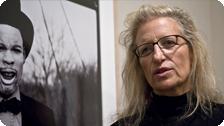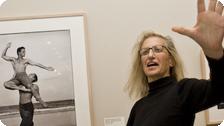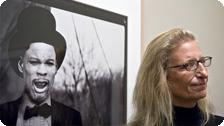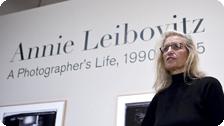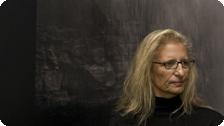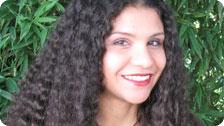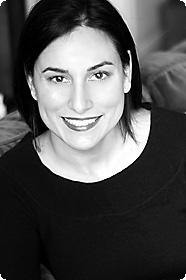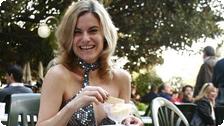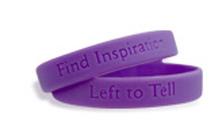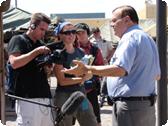Visionaries: Annie Leibovitz: On a Personal Note
by Stephanie Block
Of course you know Annie Leibovitz. Those celebrity magazine covers–Brad and Demi and Uma. They lauded her in your art classes and you might even have one of her books on your coffee table. But you’ve never, I’ve never, met Annie like this. Though she likes to insist that it’s impossible to capture a person’s essence on camera, her latest exhibition comes as close as it’s possible to the artist’s herself.
Press passes are awesome. Her newest exhibit had come to town: Annie Leibovitz: A Photographer’s Life, 1990-2005, and we press persons were invited to check it out before it opened, uh, with Annie on hand to lead us through the rooms. Wowza.
She walked into our Legion of Honor museum (a neo-classical palace of art high on a foggy, Golden Gate Bridge viewed hill), so unassumingly dressed in a black turtleneck sweater, black pants, and blue Nike tennis shoes with bright red swooshes on them, that if socialite to-be-reckoned-with Dede Wilsey (bejeweled in a green cocktail suit at nine AM??) hadn’t made such a fuss over her, you might think Annie was one of us four-eyed press folk. And she was a total press subject’s subject—appreciative, candid, and generously unhurried.
As the eloquent Fine Arts Museum Director, John Buchanan, said of her work: “I see my own life flash before my eyes of the last 25 years, those who shape our lives everyday, but through her own voice. The eye of a painter is one of her lenses if you will excuse the pun.”
Okay, I’m going to stop talking now and let Annie (first name basis? Only because she was sooo friendly to us) do the rest, although I must gush that this reporter’s favorite photographs from the show were the one of Leonardo DiCaprio with the swan, the William S. Burroughs series, the photo of the orphaned Sarajevo bicycle with the smear of blood on the pavement, that one of Annie’s mother we’ll discuss later, the White Stripes in a circus, R2-D2, the one of Patti Smith and her kids, and the one of Annie’s totally hot brother.
Enjoy!
* * * *
ON SAN FRANCISCO:
Annie Leibovitz was excited to be back in San Francisco (“I’ll never forgive Jann for moving Rolling Stone to New York,” Annie told us. “It’s pretty heady stuff to be here today.”), where she had attended the Art Institute —not in the photography department but as a painter, thus the painterly lens that the museum guy was talking about.
“Everyone’s work was amazing,” she says. “I was not one of the best photographers there.” She also has two sisters in the Bay Area.
ON THE SHOW:
“You’re going to learn the most by looking back at your work in order to move forward. 1990-2005 came out of a moment.” Susan Sontag, celebrated writer, playwright and Annie’s partner of fifteen years, had lost her battle with cancer, and Annie’s father died a few weeks later. “I was working on a small book for Susan’s memorial service. I realized that the old photos told a story.”
Annie was also going through family photos. “I brought these two together. It came out of grief; I almost started to shudder as I looked at the show—oh my God, I really opened myself up. I won’t do this again—this is it.”
The show is loosely chronological and takes place over continents too, with images hailing from Mexico, Berlin, Venice, Sarajevo. Paris, Bilbao, Jordan, Egypt and Rwanda. Yet they are all close to home both emotionally and physically—“The Brooklyn Museum is family oriented. I thought that we could recreate my barn walls exactly the way they were,” with photos haphazardly stuck here and there figuring out their order of her book. Some are even outtakes that never made it in.
Annie’s family photos are smaller than the celebrity photos, “the idea being that in a gallery you’d walk up to them. Very few are over 8×10. To me it all goes back to beginning–differentiating between personal and intimate work and magazine assignments.”
ON CELEBRITY:
“I’ve always hated the word ‘celebrity’. It’s wrong to assume they’re your friend—you are there to do a job. It’s just you and the subject—it couldn’t be more frightening. The thing that saved me is that photography was the most important thing. I admire the people—it’s healthy to admire them, but I’m still enamored with the process.
[In fact her attitude when she was younger was: “This person is lucky to be in the photograph.”] If I’m successful at all it’s because I got right to work and was not looking for anything more than the picture.”
“[Magazine] covers are like advertising–they have to sell. They’re not photographic—they’re something else.”
ON HER WORK:
“At it’s best my work shows us our life and time. One of my weaknesses? I like to like people. My photos are always going to be gushy and soft. I can’t be Diane Arbus. I’m too nice. Put me in a room with Nixon and I’m like – he’s a nice guy. It’s bad—it’s not a good thing.”
“We are so complicated—unless you are Sylvester Stallone—that you can’t capture someone’s essence.”
Whom does she regret not getting to shoot? Martha Graham, Elvis, Mother Teresa.
ON THE EXHIBIT’S PHOTOGRAPHS:
1. Mikhail Baryshnikov and Rob Besserer, Cumberland Island, Georgia, 1990:
“Mom danced her whole life.” There was a camp for aging dancers they jokingly referred to as The Glue Factory. Mark Morris choreographed and worked with them, and Annie spent three weeks taking portraits of all the dancers, likening it to Barbara Morgan’s work with Martha Graham. She was not afraid to pair same sexes together, and “Baryshnikov had no knees left,” thus the photo of him being lifted by Rob Besserer.
2. Demi Moore, Los Angeles, 1991:
“I had photographed Bruce and Demi’s wedding.” Then Rolling Stone sent Annie to do a shot of pregnant Demi. “Everyone was thinking, How can we disguise the pregnancy? How to evade it. When you’re pregnant you go off in a corner and have a baby.” But, “when a woman is pregnant, you think you’re real beautiful. That’s what’s coming out…”
Working with Demi was “always like running behind a car. She always wanted to do things differently. She directed me. I couldn’t keep up with her.”
3. Cindy Sherman, Vandam Street, studio, New York, 1992:
She showed up at Annie’s studio in a white shirt tucked into black pants. It wasn’t that interesting. The idea came to do a line of Cindys, only Annie didn’t realize that Cindy’s plain outfit was actually head-to-toe couture. So she grabbed some black Gap pants and white shirts.
Later, when she was doing a portrait of Claire Danes, the actress said to her, “We’ve met before.” Annie asked when, and Claire replied, “I was one of the Cindys. You put me on the end and cut me out of the photo!”
4. My mother at Clifton Point, 1997:
Annie told us that for her mom’s whole life, taking pictures was about smiling. “Most of the time she was not always smiling—this was real to me. I wanted her to look her age. She was very nervous—‘I’m afraid I’m gonna look old!’”
“I thought she was beautiful, looking strong with great intelligence. She didn’t like it. Dad didn’t like it. He said, ‘She’s not smiling!’” But Annie’s mom started liking the picture in DC when the show opened and everyone wanted her to sign the book. “There’s a whole story on celebrity there,” mused Annie.
The picture of her mother Annie “could look at for a long time. It’s probably my strongest portrait in show. Because capturing someone’s soul just doesn’t happen; it’s 2-D. It’s going to have to be someone like your mother. My favorite photos are Stieglitz’s photos of O’Keefe because they loved each other. They make my knees weak. This show is closer to my heart than anything.”
5. Secretary of State Colin L. Powell, Vice President Richard B. Cheney, President George W. Bush, National Security Advisor Condoleezza Rice, White House Chief of Staff Andrew H. Card, Jr., C.I.A. Director GeoGabinet Room, The White House, Washington, D.C., December 2001:
“I learned early on—you don’t have to like them. I wouldn’t be doing my job.”
Annie says that she felt, “A little skuzzy – you have to take a bath afterwards. Vogue is politically correct,” meaning that you have to shoot Republicans, too. “Feels like a recon mission,” Annie told us. Regarding Bush, she said, “He stood like a Texan ‘rrrr.’ He’s very cocky, put his hands in his pockets. Things aren’t good right now but he looks like he just got out of a spa—he should look awful. I don’t think he takes it in.”
“That’s the funny thing about politicians–they don’t know what they’re doing. They put on that pancake make-up. Like TV.”
6. Phillip Johnson Glass House, New Canaan, CT, 2000:
Annie showed up at the Glass House expecting it to be empty, but it turned out that Phillip Johnson was home. “I was miffed,” Annie told us. But it turned out great in the end. Annie said that she asked a stupid question, “How do you get air in here?” Phillip looked at her and said, “We can open the doors.”
7. Her Majesty Queen Elizabeth II, Buckingham Palace, London, 2007:
It was the “typical story—Buckingham Palace is on the phone. Oh yeah right.” The movie, The Queen, had just come out, so “we were all feeling squishy about queens.” Annie had the idea that, “I think Americans would like to see her outside.”
“It dawned on me that she’s in her 80’s. It’s like photographing your great aunt. She was cranky, and she has every right to be.” In the photos in The White Drawing Room, “she’s got 75 pounds of cape dragging it down hallway.”
They were making a BBC documentary at the same time, and it seemed like they wanted Annie’s shooting to be part of it. But if you ever see that video, Annie exclaimed that it looks like she’s ordering the queen to take off her crown for the shot and the queen storms off. That’s not what happened. And no, she didn’t have a purse that day.
Had Annie ever photographed Diana? They had talked once on the phone and scheduled a portrait sitting in October because Annie takes the end of August off. It was not meant to be.
8. Susan Sontag:
With the support of her psychiatrist, Annie was able to put the photographs into the exhibit. People seem to appreciate it. “When something happening beyond your control, you resort to what you know. I’m glad I have the photos.”
9. The Landscapes
The exhibit ends with some of Annie’s landscapes which offer an emotional relief, something that Annie is glad that San Francisco did.
* * * *
“I think I’ve showed everything now—it’s all out there. I’ve got nothing to hide!”
* * * *
FOR MORE INFORMATION:
The Book:
A Photographer’s Life: 1990-2005.
(“I think as far as books go it’s too heavy. I thought someone would tell me to edit it, but no one did.”)
The Exhibit:
March 1 – May 25, 2008 @ Legion of Honor Museum
Lincoln Park
34th Avenue & Clement Street
San Francisco, CA 94121
415.750.3600
The exhibit is from the Brooklyn Museum of Art, and this is its last American stop before it travels abroad.
The Art of Photography:
To learn more about photography, check out these Annie-recommended artists: Richard Avedon, Diane Arbus, Henri Cartier-Bresson, Robert Frank
* * * *
*All photographs were taken by Photographic Diva Mona Brooks. Visit her work at www.monabrooks.com.
Discover more from Tango Diva
Subscribe to get the latest posts sent to your email.
